SummaryofFunctionofCranial Nerves Figure 13. 5 b

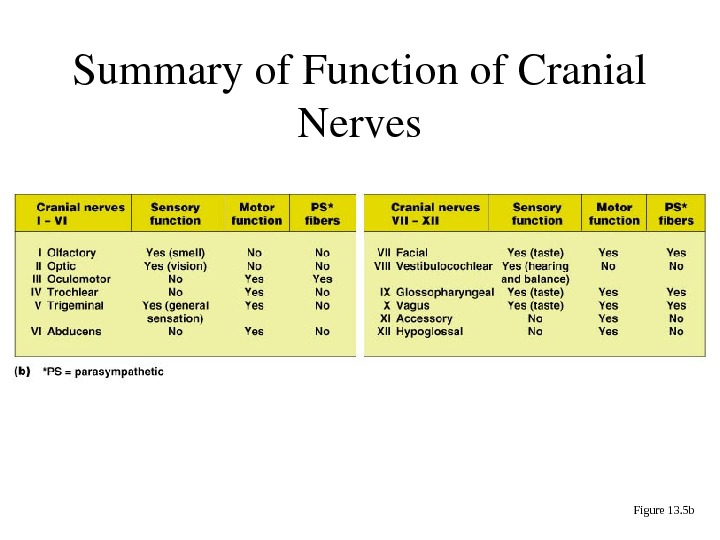

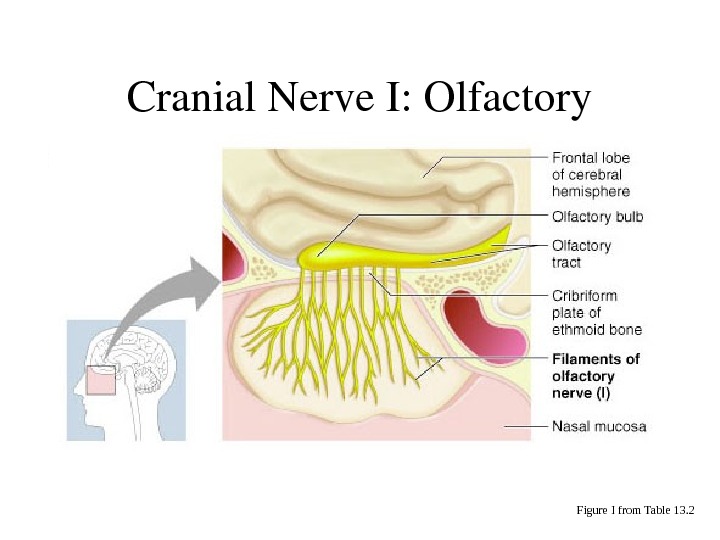
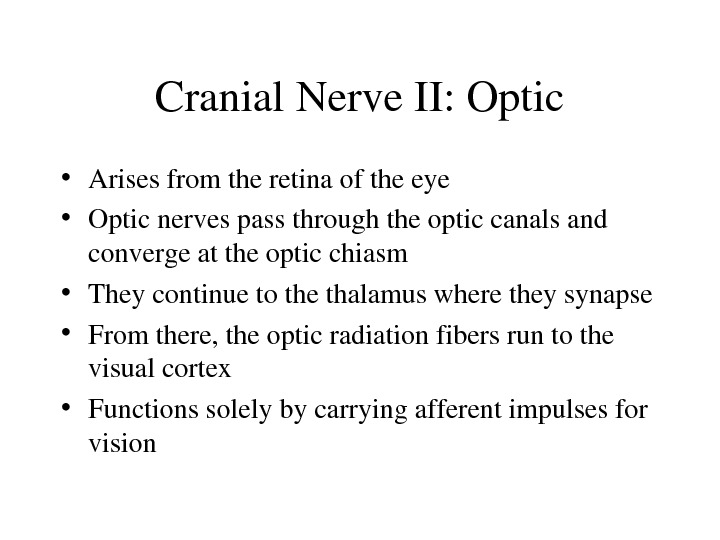
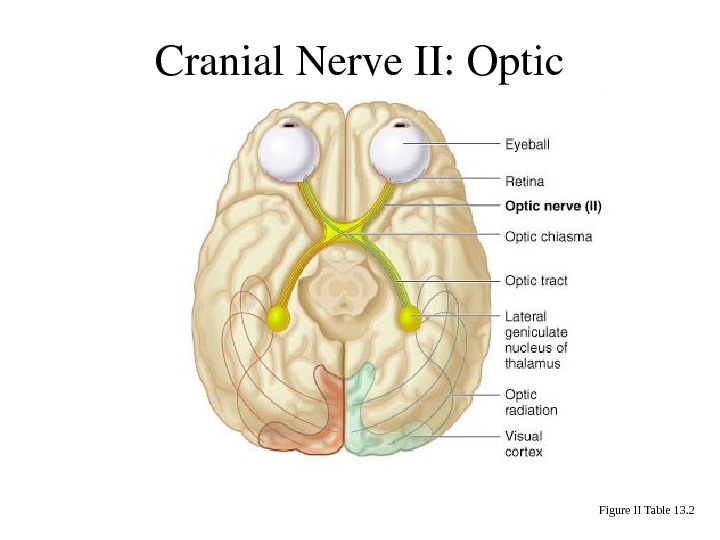
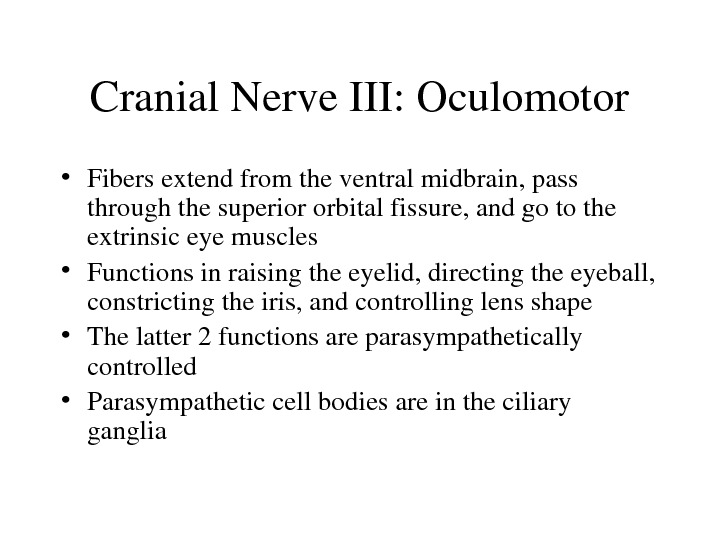
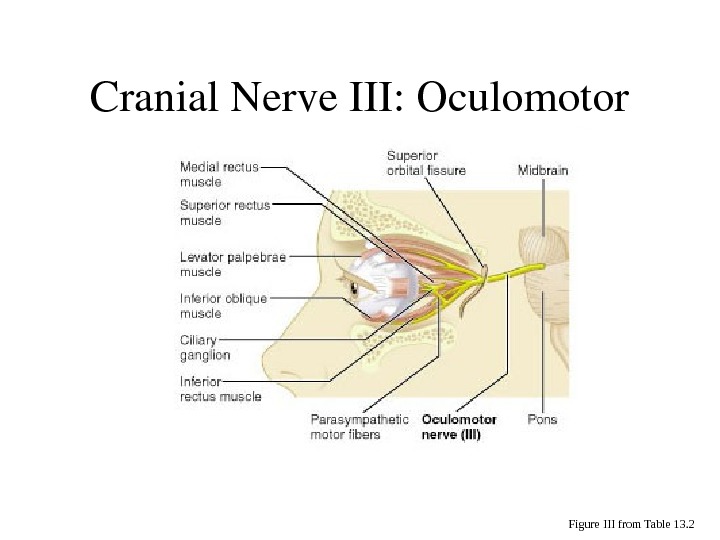
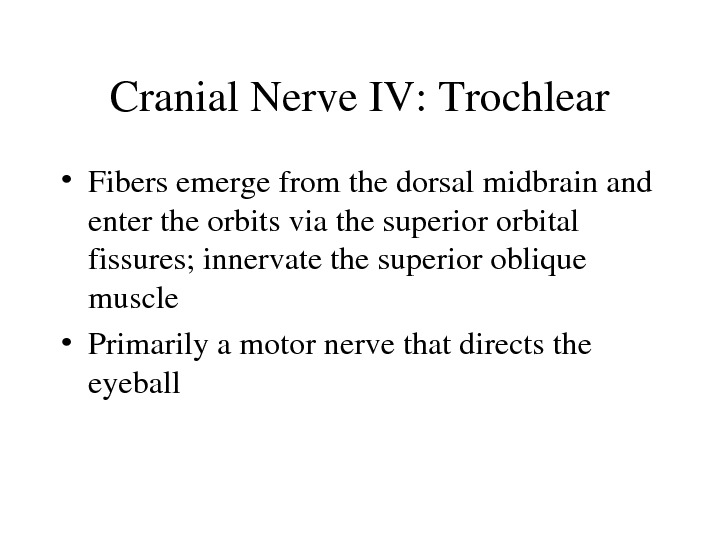

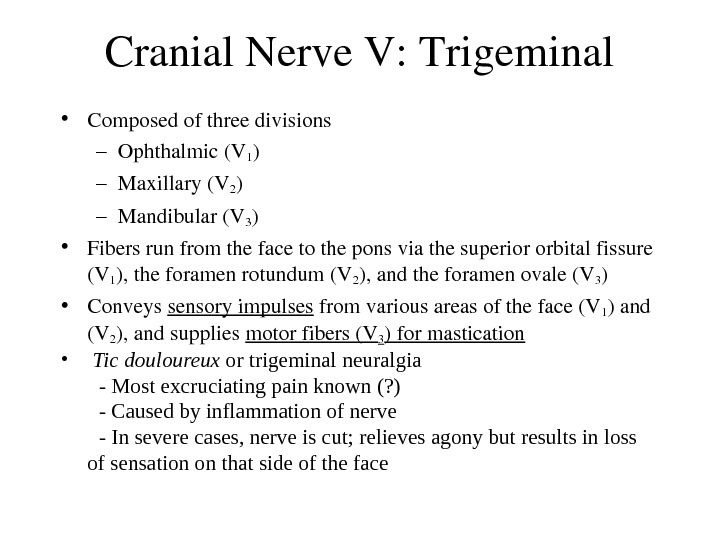
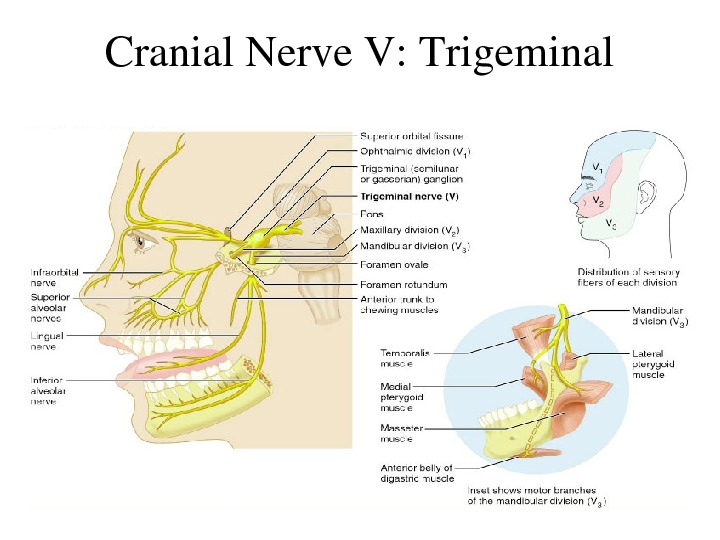
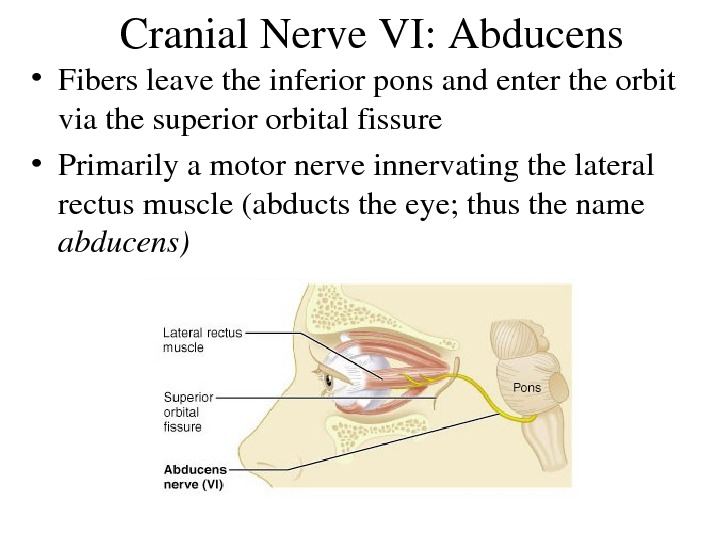
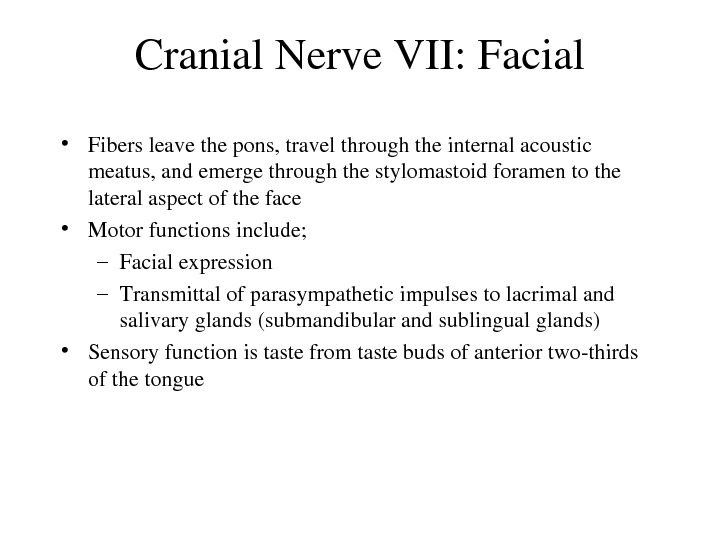
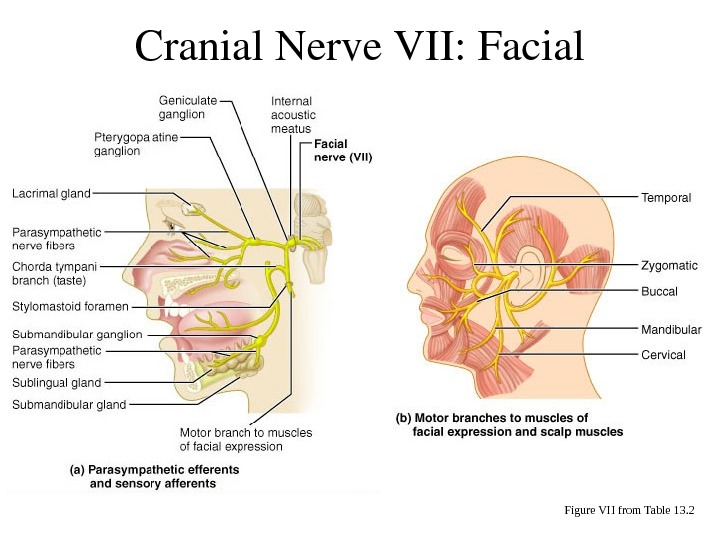

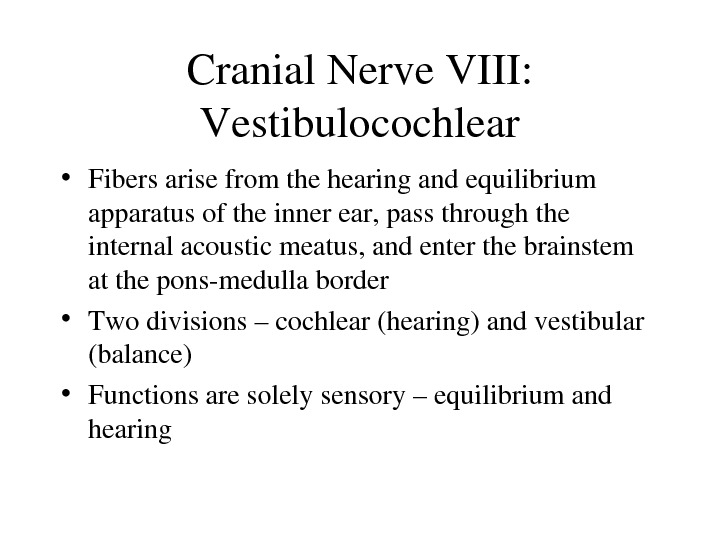
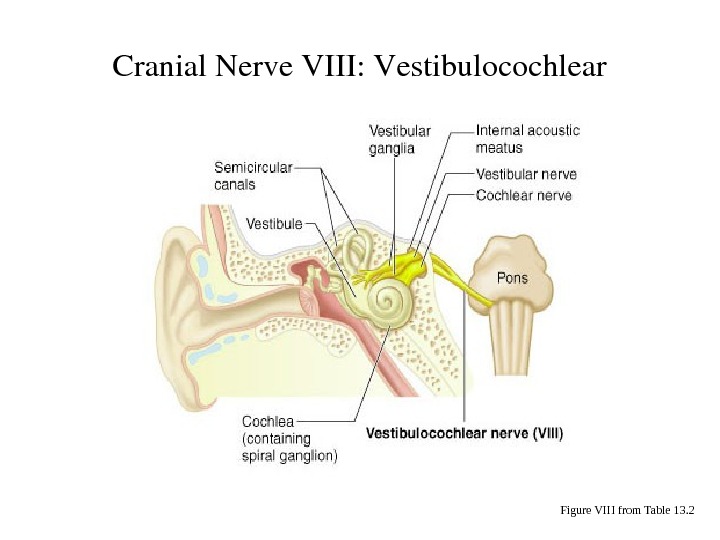
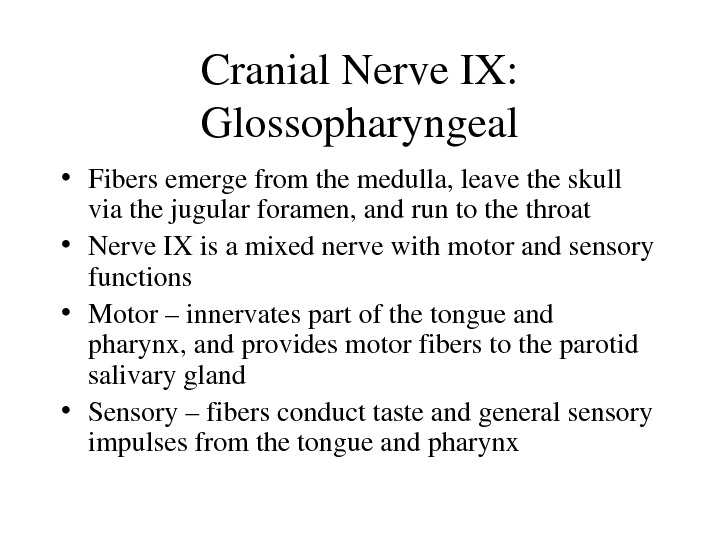
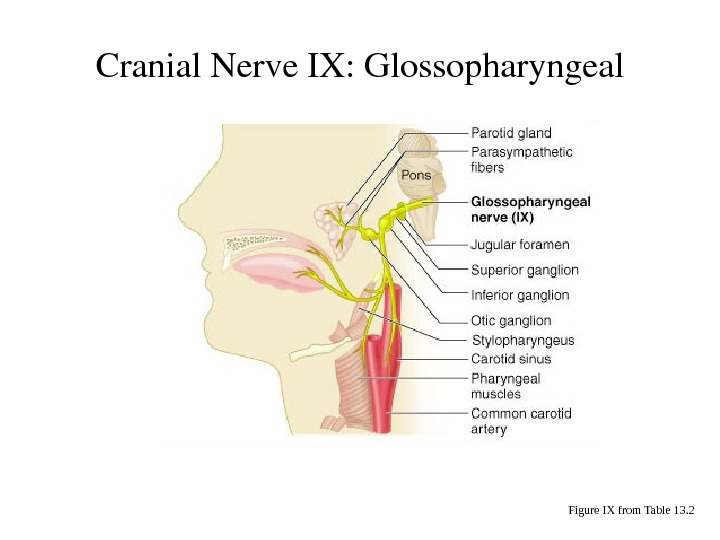

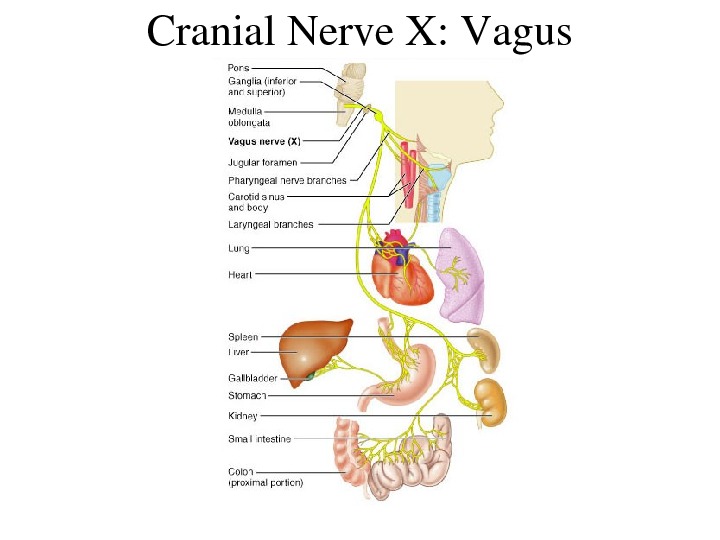
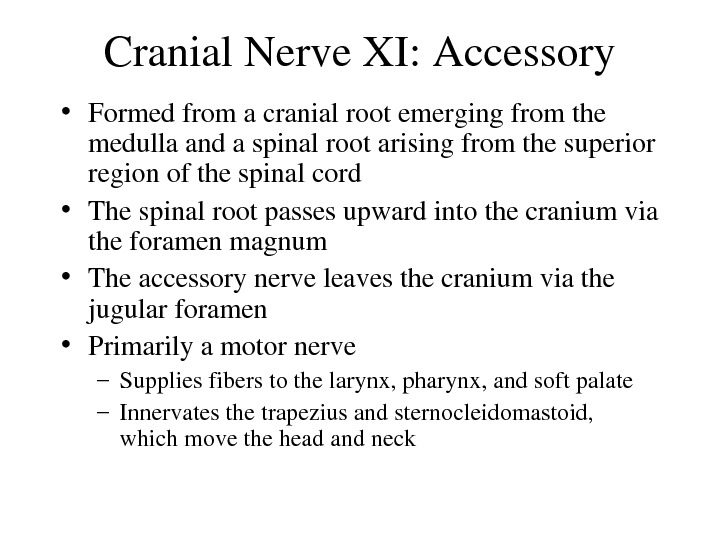
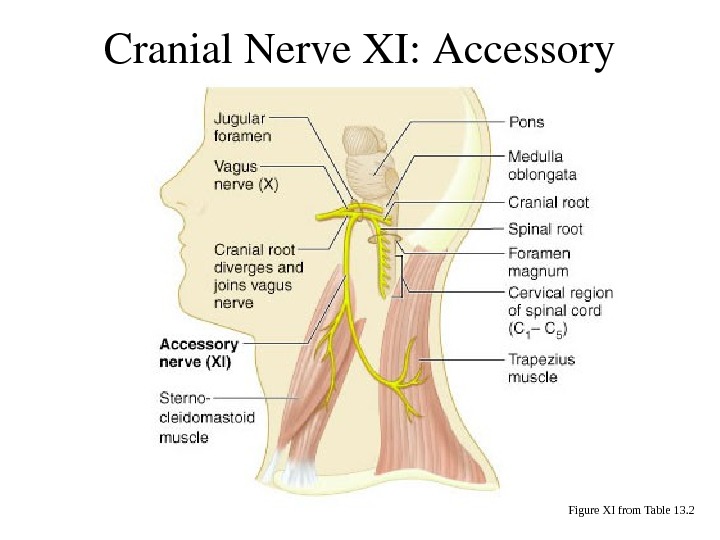
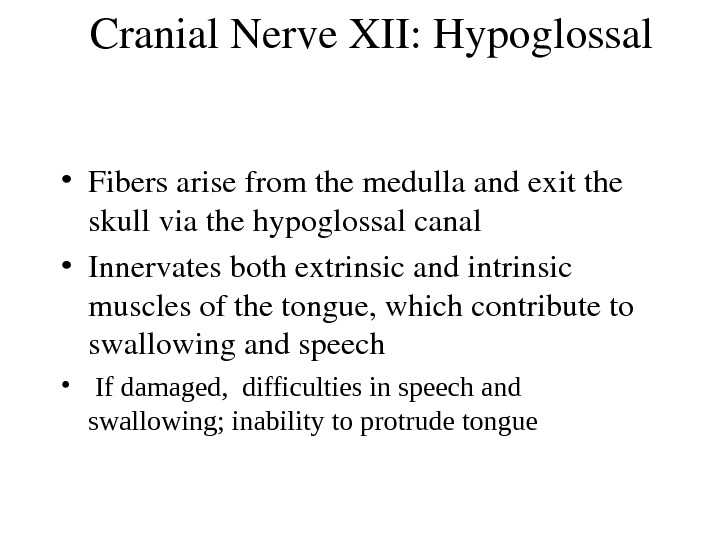
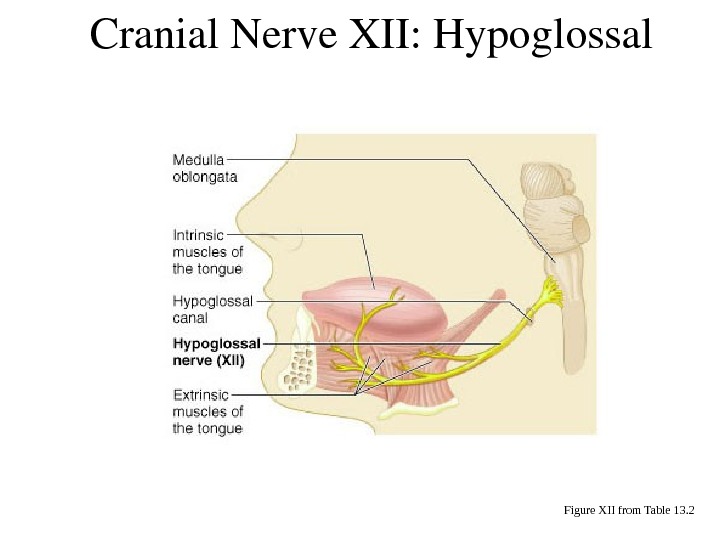
- Размер: 1.4 Mегабайта
- Количество слайдов: 25
Описание презентации SummaryofFunctionofCranial Nerves Figure 13. 5 b по слайдам
 Summaryof. Functionof. Cranial Nerves Figure 13. 5 b
Summaryof. Functionof. Cranial Nerves Figure 13. 5 b
 Cranial. Nerve. I: Olfactory • Arisesfromtheolfactoryepithelium • Passesthroughthecribriformplateofthe ethmoidbone • Fibersrunthroughtheolfactorybulband terminateintheprimaryolfactorycortex • Functionssolelybycarryingafferent impulsesforthesenseofsmell
Cranial. Nerve. I: Olfactory • Arisesfromtheolfactoryepithelium • Passesthroughthecribriformplateofthe ethmoidbone • Fibersrunthroughtheolfactorybulband terminateintheprimaryolfactorycortex • Functionssolelybycarryingafferent impulsesforthesenseofsmell
 Cranial. Nerve. I: Olfactory Figure I from Table 13.
Cranial. Nerve. I: Olfactory Figure I from Table 13.
 Cranial. Nerve. II: Optic • Arisesfromtheretinaoftheeye • Opticnervespassthroughtheopticcanalsand convergeattheopticchiasm • Theycontinuetothethalamuswheretheysynapse • Fromthere, theopticradiationfibersruntothe visualcortex • Functionssolelybycarryingafferentimpulsesfor vision
Cranial. Nerve. II: Optic • Arisesfromtheretinaoftheeye • Opticnervespassthroughtheopticcanalsand convergeattheopticchiasm • Theycontinuetothethalamuswheretheysynapse • Fromthere, theopticradiationfibersruntothe visualcortex • Functionssolelybycarryingafferentimpulsesfor vision
 Cranial. Nerve. II: Optic Figure II Table 13.
Cranial. Nerve. II: Optic Figure II Table 13.
 Cranial. Nerve. III: Oculomotor • Fibersextendfromtheventralmidbrain, pass throughthesuperiororbitalfissure, andgotothe extrinsiceyemuscles • Functionsinraisingtheeyelid, directingtheeyeball, constrictingtheiris, andcontrollinglensshape • Thelatter 2 functionsareparasympathetically controlled • Parasympatheticcellbodiesareintheciliary ganglia
Cranial. Nerve. III: Oculomotor • Fibersextendfromtheventralmidbrain, pass throughthesuperiororbitalfissure, andgotothe extrinsiceyemuscles • Functionsinraisingtheeyelid, directingtheeyeball, constrictingtheiris, andcontrollinglensshape • Thelatter 2 functionsareparasympathetically controlled • Parasympatheticcellbodiesareintheciliary ganglia
 Cranial. Nerve. III: Oculomotor Figure III from Table 13.
Cranial. Nerve. III: Oculomotor Figure III from Table 13.
 Cranial. Nerve. IV: Trochlear • Fibersemergefromthedorsalmidbrainand entertheorbitsviathesuperiororbital fissures; innervatethesuperioroblique muscle • Primarilyamotornervethatdirectsthe eyeball
Cranial. Nerve. IV: Trochlear • Fibersemergefromthedorsalmidbrainand entertheorbitsviathesuperiororbital fissures; innervatethesuperioroblique muscle • Primarilyamotornervethatdirectsthe eyeball
 Cranial. Nerve. IV: Trochlear Figure IV from Table 13.
Cranial. Nerve. IV: Trochlear Figure IV from Table 13.
 Cranial. Nerve. V: Trigeminal • Composedofthreedivisions – Ophthalmic(V 1 ) – Maxillary(V 2 ) – Mandibular(V 3 ) • Fibersrunfromthefacetotheponsviathesuperiororbitalfissure (V 1 ), theforamenrotundum(V 2 ), andtheforamenovale(V 3 ) • Conveys sensoryimpulses fromvariousareasoftheface(V 1 )and (V 2 ), andsupplies motorfibers(V 3 )formastication • Tic douloureux or trigeminal neuralgia — Most excruciating pain known (? ) — Caused by inflammation of nerve — In severe cases, nerve is cut; relieves agony but results in loss of sensation on that side of the face
Cranial. Nerve. V: Trigeminal • Composedofthreedivisions – Ophthalmic(V 1 ) – Maxillary(V 2 ) – Mandibular(V 3 ) • Fibersrunfromthefacetotheponsviathesuperiororbitalfissure (V 1 ), theforamenrotundum(V 2 ), andtheforamenovale(V 3 ) • Conveys sensoryimpulses fromvariousareasoftheface(V 1 )and (V 2 ), andsupplies motorfibers(V 3 )formastication • Tic douloureux or trigeminal neuralgia — Most excruciating pain known (? ) — Caused by inflammation of nerve — In severe cases, nerve is cut; relieves agony but results in loss of sensation on that side of the face
 Cranial. Nerve. V: Trigeminal
Cranial. Nerve. V: Trigeminal
 Cranial. Nerve. VI: Abducens • Fibersleavetheinferiorponsandentertheorbit viathesuperiororbitalfissure • Primarilyamotornerveinnervatingthelateral rectusmuscle(abductstheeye; thusthename abducens)
Cranial. Nerve. VI: Abducens • Fibersleavetheinferiorponsandentertheorbit viathesuperiororbitalfissure • Primarilyamotornerveinnervatingthelateral rectusmuscle(abductstheeye; thusthename abducens)
 Cranial. Nerve. VII: Facial • Fibersleavethepons, travelthroughtheinternalacoustic meatus, andemergethroughthestylomastoidforamentothe lateralaspectoftheface • Motorfunctionsinclude; – Facialexpression – Transmittalofparasympatheticimpulsestolacrimaland salivaryglands(submandibularandsublingualglands) • Sensoryfunctionistastefromtastebudsofanteriortwothirds ofthetongue
Cranial. Nerve. VII: Facial • Fibersleavethepons, travelthroughtheinternalacoustic meatus, andemergethroughthestylomastoidforamentothe lateralaspectoftheface • Motorfunctionsinclude; – Facialexpression – Transmittalofparasympatheticimpulsestolacrimaland salivaryglands(submandibularandsublingualglands) • Sensoryfunctionistastefromtastebudsofanteriortwothirds ofthetongue
 Cranial. Nerve. VII: Facial Figure VII from Table 13.
Cranial. Nerve. VII: Facial Figure VII from Table 13.
 Facial. Nerve(CNVII) • Bell’spalsy : paralysisoffacialmuscleson affectedsideandlossoftastesensation • Causedbyherpessimplex. Ivirus • Lowereyeliddroops • Cornerofmouthsags • Tearsdripcontinuouslyandeyecannotbe completelyclosed(dryeyemayoccur) • Conditionmydisappearspontaneouslywithout treatment
Facial. Nerve(CNVII) • Bell’spalsy : paralysisoffacialmuscleson affectedsideandlossoftastesensation • Causedbyherpessimplex. Ivirus • Lowereyeliddroops • Cornerofmouthsags • Tearsdripcontinuouslyandeyecannotbe completelyclosed(dryeyemayoccur) • Conditionmydisappearspontaneouslywithout treatment
 Cranial. Nerve. VIII: Vestibulocochlear • Fibersarisefromthehearingandequilibrium apparatusoftheinnerear, passthroughthe internalacousticmeatus, andenterthebrainstem attheponsmedullaborder • Twodivisions–cochlear(hearing)andvestibular (balance) • Functionsaresolelysensory–equilibriumand hearing
Cranial. Nerve. VIII: Vestibulocochlear • Fibersarisefromthehearingandequilibrium apparatusoftheinnerear, passthroughthe internalacousticmeatus, andenterthebrainstem attheponsmedullaborder • Twodivisions–cochlear(hearing)andvestibular (balance) • Functionsaresolelysensory–equilibriumand hearing
 Cranial. Nerve. VIII: Vestibulocochlear Figure VIII from Table 13.
Cranial. Nerve. VIII: Vestibulocochlear Figure VIII from Table 13.
 Cranial. Nerve. IX: Glossopharyngeal • Fibersemergefromthemedulla, leavetheskull viathejugularforamen, andruntothethroat • Nerve. IXisamixednervewithmotorandsensory functions • Motor–innervatespartofthetongueand pharynx, andprovidesmotorfiberstotheparotid salivarygland • Sensory–fibersconducttasteandgeneralsensory impulsesfromthetongueandpharynx
Cranial. Nerve. IX: Glossopharyngeal • Fibersemergefromthemedulla, leavetheskull viathejugularforamen, andruntothethroat • Nerve. IXisamixednervewithmotorandsensory functions • Motor–innervatespartofthetongueand pharynx, andprovidesmotorfiberstotheparotid salivarygland • Sensory–fibersconducttasteandgeneralsensory impulsesfromthetongueandpharynx
 Cranial. Nerve. IX: Glossopharyngeal Figure IX from Table 13.
Cranial. Nerve. IX: Glossopharyngeal Figure IX from Table 13.
 Cranial. Nerve. X: Vagus • Theonlycranialnervethatextendsbeyondthehead andneck • Fibersemergefromthemedullaviathejugular foramen • Thevagusisamixednerve • Mostmotorfibersareparasympatheticfiberstothe heart, lungs, andvisceralorgans • Itssensoryfunctionisintaste • Paralysis leads to hoarseness • Total destruction incompatible with life
Cranial. Nerve. X: Vagus • Theonlycranialnervethatextendsbeyondthehead andneck • Fibersemergefromthemedullaviathejugular foramen • Thevagusisamixednerve • Mostmotorfibersareparasympatheticfiberstothe heart, lungs, andvisceralorgans • Itssensoryfunctionisintaste • Paralysis leads to hoarseness • Total destruction incompatible with life
 Cranial. Nerve. X: Vagus
Cranial. Nerve. X: Vagus
 Cranial. Nerve. XI: Accessory • Formedfromacranialrootemergingfromthe medullaandaspinalrootarisingfromthesuperior regionofthespinalcord • Thespinalrootpassesupwardintothecraniumvia theforamenmagnum • Theaccessorynerveleavesthecraniumviathe jugularforamen • Primarilyamotornerve – Suppliesfiberstothelarynx, pharynx, andsoftpalate – Innervatesthetrapeziusandsternocleidomastoid, whichmovetheheadandneck
Cranial. Nerve. XI: Accessory • Formedfromacranialrootemergingfromthe medullaandaspinalrootarisingfromthesuperior regionofthespinalcord • Thespinalrootpassesupwardintothecraniumvia theforamenmagnum • Theaccessorynerveleavesthecraniumviathe jugularforamen • Primarilyamotornerve – Suppliesfiberstothelarynx, pharynx, andsoftpalate – Innervatesthetrapeziusandsternocleidomastoid, whichmovetheheadandneck
 Cranial. Nerve. XI: Accessory Figure XI from Table 13.
Cranial. Nerve. XI: Accessory Figure XI from Table 13.
 Cranial. Nerve. XII: Hypoglossal • Fibersarisefromthemedullaandexitthe skullviathehypoglossalcanal • Innervatesbothextrinsicandintrinsic musclesofthetongue, whichcontributeto swallowingandspeech • If damaged, difficulties in speech and swallowing; inability to protrude tongue
Cranial. Nerve. XII: Hypoglossal • Fibersarisefromthemedullaandexitthe skullviathehypoglossalcanal • Innervatesbothextrinsicandintrinsic musclesofthetongue, whichcontributeto swallowingandspeech • If damaged, difficulties in speech and swallowing; inability to protrude tongue
 Cranial. Nerve. XII: Hypoglossal Figure XII from Table 13.
Cranial. Nerve. XII: Hypoglossal Figure XII from Table 13.

